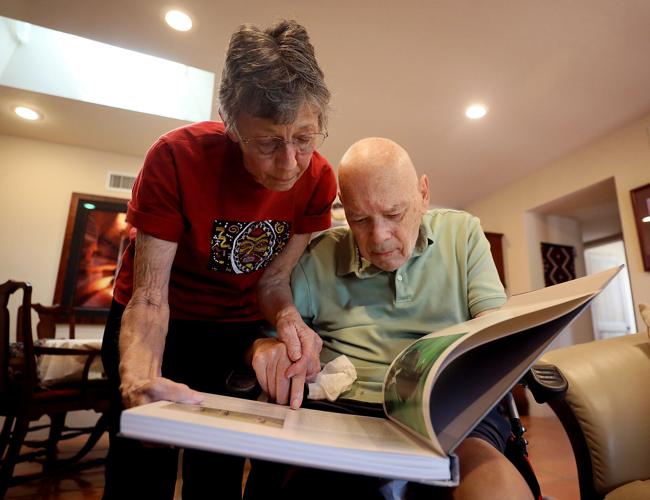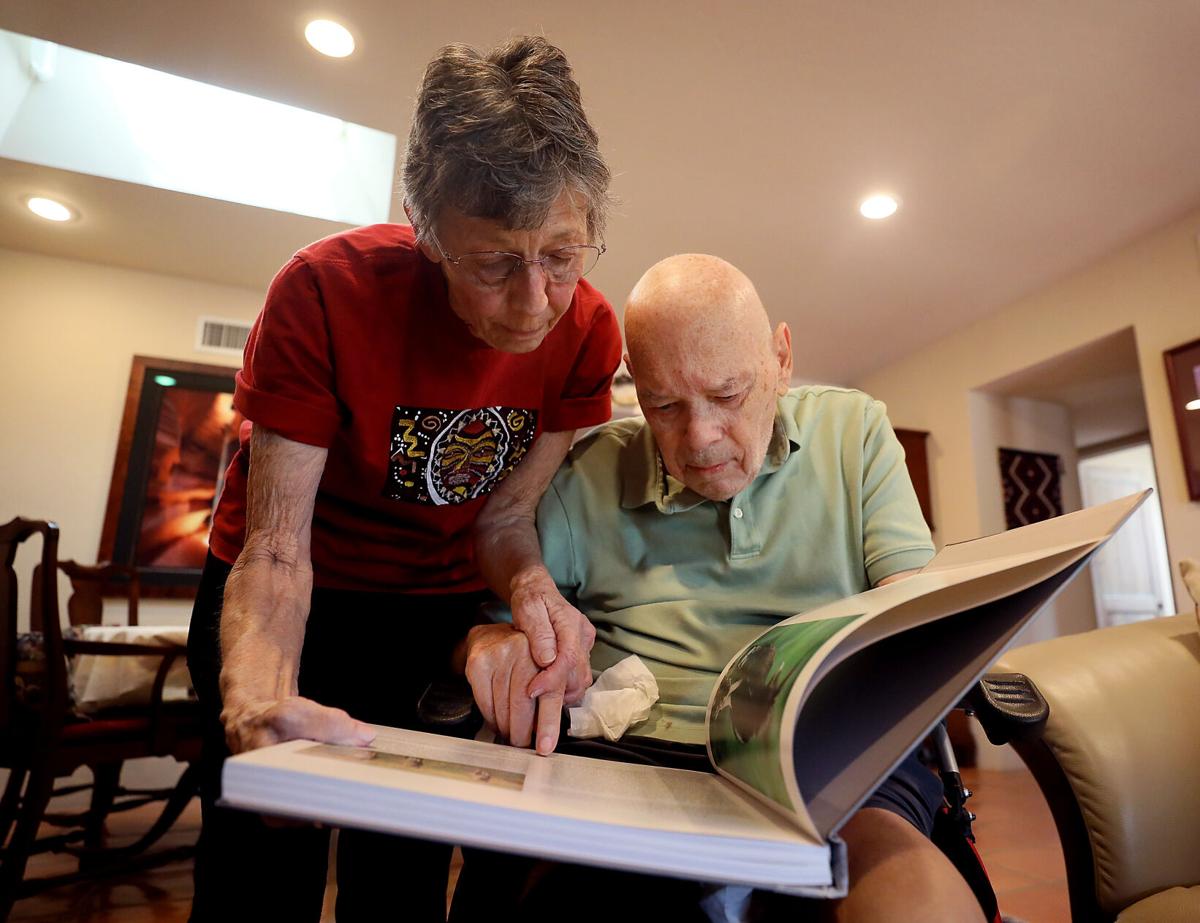Frank Walsh captured cloudy mountain peaks, streams of light though canyon walls, and African safari animals caring for their young.
David and Nicolette Luery have treasured shots of the European cities they visited — and wildlife encountered along their many journeys — thanks to Nicolette’s passion for photography.
Some of their photos, and the creative endeavors of several other local artists, will be on display from 10 a.m. to 1 p.m. Sunday, Oct. 23, at the Tucson Museum of Art‘s “Art Through the Ages,” 140 N. Main Ave.
What’s unique about this show? The artists are all senior citizens, and about half are living with memory loss. The event, which also includes watercolor and colored pencil pieces, is a fundraiser for a new nonprofit, Dementia Friendly Tucson. (Admission is free, but donations are welcome. People are asked to register at elderhealthathome.com, although it’s not required).
“Art offers people of all ages the ability to exercise their brains in creative and unique ways,” said Katie Purdy, an art therapist who works with seniors through ElderHealth, a local medical practice that provides at-home geriatric care.
“Art also offers an outlet for stress and can be used as a way for families to bond with one another in new ways when some of the activities previously enjoyed are no longer accessible.”
Purdy and several others will speak about their work, and about the new nonprofit, at the Tucson Museum of Art event Sunday.
“Aging can be a time of stress and difficulty not only for the individual going through the process of aging but for the family members of the loved one,” she said. “Art can bring joy and vitality to the aging process, and help families come together to enjoy life together through art.”
Dementia numbers are growing
The idea behind Dementia Friendly Tucson is to better support residents with memory loss, along with their caregivers, by increasing access to local businesses and events, said Kim Shea, a registered nurse and professor with the University of Arizona’s College of Nursing.
In the Netherlands, Shea explained, there is a dementia village which includes trained staff in stores, coffee shops, and restaurants who understand the challenges of memory loss, and how to help.
“Our idea is to approach restaurants, and movie theaters, and ask them to be part of Dementia Friendly Tucson,” she said. Businesses that participate would then put a sticker in the window, for example, to show staff have been trained. There also could be designated times for caregivers to bring loved ones with memory loss to a movie, as another example.
It’s an important undertaking, Shea said, because the number of people experiencing memory loss continues to grow.
Predictions vary, but researchers agree the number of people living with dementia will continue to increase dramatically as the population ages. At least 140,000 people in Arizona, including roughly 21,000 people in Pima County, are living with Alzheimer’s disease and other forms of dementia.
Alzheimer’s is a progressive, irreversible disorder, and is the most common form of dementia. It develops when brain cells stop functioning and eventually die, affecting thinking, remembering and using language.
By 2025, it is predicted Arizona will have 200,000 residents living with Alzheimer’s disease, according to the national Alzheimer’s Association.

A photo of a Upper Antelope Canyon in Page, taken by Frank Walsh in 2003. The photo will be displayed in the "Art Through the Ages" exhibit on Oct. 23.
‘Different realities’
What defines Nicolette Luery — her love of photography, her career as a clinical pharmacist — stayed with her even as Alzheimer’s disease took hold.
David Luery said his 73-year-old wife worked as a clinical pharmacist, specializing initially in pediatric oncology, and later working as a national scientific director in Pfizer‘s oncology division. She has long enjoyed photography as a hobby, especially capturing birds, animals, and the places they traveled together over the years.
When they go out for walks now, he said, “it’s almost like magic, how she spots the rabbits and spots the birds.” The couple met on a blind date and have been married 51 years.
Much of Nicolette Luery’s medical care now comes from ElderHealth. David Luery has contributed to their blog, detailing what it can be like when first adjusting to a loved one’s diagnosis.
“I certainly made mistakes,” he said. “She kept thinking she was still working and had meetings to go to.”

A photo of a leopard taken by Frank Walsh in the Maasai Mara National Reserve in Kenya in early 2000s. Walsh waited for a long time for the animal to wake up in order to get this photo, resulting in sunburning his hands.
Luery said his wife was diagnosed two days before the World Health Organization announced the pandemic, which made Nicolette Luery’s insistence that they go out in the car harder to manage.
“At the outset of my wife’s disease, she and I were essentially on our own in learning to live with and manage this new reality,” Luery wrote. “As I eventually figured out, however, that reality was not mutually shared; it became apparent that she and I saw different realities.”
He learned, over time, that the best way to help was to play along, and volunteer to take her to that meeting. He said they’d hop in the car and drive around for a while, until the urgency to get to the meeting abated, and then go home.
David Luery welcomes the idea of making Tucson more dementia friendly.
“She’s basically here all the time, and I don’t think she minds it,” he said of their east-side home. However, he said, “I would like to have places to take her.”

Photographs by Nicolette Luery
‘What people are, not what they were’
Frank Walsh is not challenged by memory loss, but instead has progressive supranuclear palsy, an uncommon brain disorder which causes him extreme muscle weakness and has mostly robbed him of his ability to speak.
During a recent visit to the home he shares with his wife, Pat, he used hand signals to answer questions about his photography, and also shared two hardcover books their daughters made of his photographs. Pat Walsh filled in when she could.
Walsh purchased his first camera in 1973, a simple camera for a trip to Italy and Switzerland. He was traveling a lot at that time for work, and for pleasure, including trips throughout the United States, Europe, and Israel.
The couple, now married 58 years, ventured to Yellowstone National Park for three winters to capture shots of bison, coyotes and wolves. It was bitter cold, getting as low as 40-below zero.
“Pat looked like the Michelin man dressed in a snowsuit waiting with me for hours in the cold for just the right light,” Frank Walsh wrote in the front of one of his photography books. In 2007, he went to Africa for the first time — a trip with friends that sparked a new passion.
In 2009, he traveled to Tanzania and saw wildebeest, wild cats, elephants, zebras and giraffes. His last Africa trip was 2010, when he led a group of five other photographers for 15 days in the Masai Mara Reserve.
“Photography has brought me much joy,” he wrote in his book, “and I will forever hold my experiences in my heart and memory.”
Pat Walsh said having this opportunity at the art museum is very therapeutic.
The art show “shows what people are, not what they were,” she said. “It’s a loss when you can’t do it anymore, but photographs give you the memories every time you look at them.”

Photographs by Nicolette Luery









